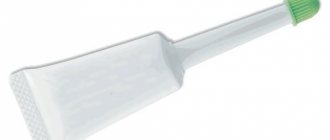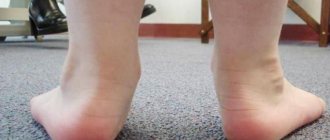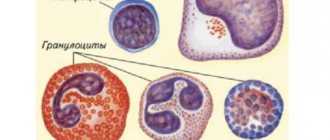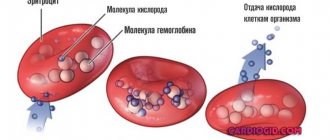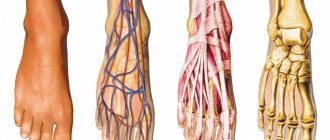Factors that provoke the occurrence of crunching in the knees
The appearance of a crunch in the knees during bending occurs under the influence of the following factors:
- If there is excessive stress, for example, when lifting heavy objects. People involved in professional sports often encounter similar problems with their knees. Such people often have to lift heavy objects and also overexert themselves when performing exercises that involve the lower extremities.
- When walking in uncomfortable shoes. High heels are harmful to both the feet and knees, as they lead to a shift in the center of gravity. In such a situation, the work of the joint increases significantly.
- For obesity. People with excess body weight often encounter a problem such as clicking in the knee joints, which is accompanied by painful sensations. In addition, such patients lose the ability to fully move and soon get tired. After some time, a destructive process begins in the joint tissue due to increased pressure on it.
- If there are no calcium-containing foods in the diet.
- With poor nutrition, excessive consumption of table salt.
- With insufficient production of hormonal substances. The occurrence of crunching occurs due to the fact that the cartilage wears out, which leads to the loss of its functionality.
Also, crunching and clicking in the joint may appear in the following cases:
- In the presence of pathological disorders in the knee joint: arthritis, bursitis, arthrosis, damage to tendon and ligament tissue, meniscus. Against the background of such pathologies, you can encounter not only the appearance of clicks in the knee, but also the appearance of pain, swelling and limitations in physical activity.
- After suffering leg injuries.
- With an abnormal structure of the knee joint, for example, with a congenital difference in the length of the lower limbs, flat feet.
- When leading a passive lifestyle, sedentary work, complete refusal to play sports.
- For osteoporosis. This disease is often diagnosed in old age.
- In professional athletes. Almost any sport involves the lower limbs, and they are maximally loaded. Regular training leads to gradual wear and tear of the joint tissue in the knees, which over time leads to the appearance of a crunch.
- Due to age-related changes. Over time, the volume of intra-articular fluid decreases, which contributes to wear and tear of the joint and loss of mobility.
When to go to the doctor
In most cases, crunching is not considered a pathology. Moreover, it is not even a sign of an advanced disease, since in the presence of the disease it physiologically cannot occur. However, we recommend not to ignore its appearance, since in some cases the danger still exists.
You should be concerned and consult a specialist if the following alarming symptoms :
- if you feel friction, as if sand is creaking inside;
- if there is pain that gets worse with movement;
- if you feel muscle tension, twitching;
- if you notice that the joint is swelling, the soft tissue around it has increased;
- if joint mobility is limited;
- if the skin in the joint area is red and “burning”;
- if the joint seems to jam when moving;
- if the muscles become weaker, they often become numb.
Healthy crackling does not recur immediately. The pathological crunch is heard constantly, and over time it only intensifies. Unlike a ringing dry crunch, which is considered normal, a pathological cracking sound in a joint has a rougher color and is accompanied by an unpleasant grinding sound.
Causes of crunching knees in children
It is interesting that not only adults, but also children sometimes experience a crunching sensation in their knees during bending. A similar phenomenon can occur against the background:
- Age characteristics. In babies under one year of age, connective tissue and muscles have not yet fully formed. When the child learns to walk, the problem will go away on its own without outside intervention.
- Genetic predisposition. Often, joint problems are hereditary and are passed on from parents to children.
- Development of arthritis. In such a situation, the baby often cries and behaves restlessly. The knee joint area becomes swollen and painful, so you should immediately consult a doctor.
- Hip dysplasia. This pathological factor is congenital. In this case, the length of the lower limbs is different, and asymmetry is observed in the inguinal folds. Treatment must be started immediately.
Diseases that provoke the appearance of crunching in the knees
The reason for the appearance of crunching in the knee joints may lie in the presence of certain pathologies. The occurrence of such a symptom is most often noted against the background of the development of these diseases:
- Gonarthrosis (arthrosis of the knee). With this disease, cartilage tissue wears out, which subsequently leads to joint deformation. This is often the reason for the assignment of disability. Women are more susceptible to the disease.
- Rheumatoid arthritis. This disease is a chronic inflammatory process in the joint tissue of the knee, which affects the synovial membrane. The cause of the pathology lies in excessive physical exertion, frequent injuries and damage to the knee.
- Chondromatosis. Often a unilateral form of the disease is diagnosed. In some cases, the disease transforms into a malignant neoplasm, although this happens quite rarely.
- Bursitis. This disease develops after injury to the knee joint, which leads to inflammation of the intra-articular cavity. In addition, pathology sometimes occurs due to excessive physical exertion.
- Osteochondritis. Over time, the cartilage plate that serves as protection for the bone peels off. The disease is found in people aged 20-40 years, mainly in men.
- Hypermobility syndrome. The reason for the crunch in this case is due to the fact that the mobility and flexibility of the joint is too active.
The cause of crunching during flexion and extension can be both pathological processes in the joint and previous injuries. In this case, the problem develops against the background:
- Injury to the meniscus. A similar problem has to be encountered if a person has jumped unsuccessfully, sharply turned his shin or straightened his knee.
- Dislocation. Problems with the functionality of the joint tissue cause clicking sounds, which are evidence of displacement of the membranes in the joint.
- Fractures. Injury to the femur, patella, and shin leads to clicking in the knee area.
- Ligament tissue injuries or sprains. The cause of the problem in this case is excessive stress on the joint tissue. This leads to a violation of the anatomy of the joints, which causes clicks to appear during movement.
It is worth noting that in some cases, the appearance of crunching in the knees is considered normal. If this phenomenon is not accompanied by hyperemia of the skin, pain and swelling are not disturbing, it is quite possible that there is no problem. Clicking sounds may indicate that the tendon and ligament tissue touches the bone when moving, which causes the crunching sound.
In addition, there are other safe reasons that lead to crunching in the knee joints:
- due to weakened ligamentous tissue, joints become more flexible;
- gas bubbles in the intra-articular fluid explode.
What do joints complain about?
One of the main reasons for cracking in the joints is wear and tear of the cartilage. Throughout life, the human body changes and is subjected to various stresses: during physical labor or sports, during pregnancy. The body grows, which means its mass increases, and accordingly, the pressure on the bones and their joints increases. Considering that constant friction during movement is added to this, it is natural that the cartilage tissue gradually becomes thinner, as a result of which the corresponding sounds appear. Other causes of creaking in joints include:
- Air bubbles. The place of their appearance is synovial fluid. Periodically, under the influence of pressure during movement, the bubbles explode. This process is accompanied by a crunch.
- Dehydration. Lack of water in the body negatively affects the joint capsule. It dries out, that is, the joints simply lack lubrication. And in this state, “dry” friction of the surfaces occurs, which can accelerate their wear.
- Physical activity without preliminary preparation, that is, without stretching and warming up. In this case, not only clicks are heard, but pain is also felt.
- Infections that provoke intense removal of water from the body. In addition to the fact that the disease causes a condition typical of dehydration, the risk of infection of the joint capsule also increases, and this is already dangerous.
- Sudden movements in the joints. In this case, the sound occurs as a result of direct contact of the ligaments with the bone.
- Increased mobility, which is normal for adolescents between 16 and 18 years of age. Gradually, as the maturation process completes, the joints will become less mobile.
- Inflammatory processes and diseases arising from this. Then the sound acts as a symptom of incipient arthritis, bursitis or tendinitis.
- Arthrosis, which affects the cartilage of the fingers, elbows and knees.
- Injuries. Because of them, microcracks appear, and a meniscus rupture is also possible.
- Salt deposits. Salts gradually fill the periarticular bursa. Over time, they cause irritation and inflammation on the articular surfaces.
- Changes in the location of ligaments and tendons. Because of this, the shape of the cartilage is deformed.
- Heredity.
- Unbalanced diet.
- Unfavorable environmental conditions.
- Bad habits.
- Excess protein in the diet. Many athletes make this mistake. They forget that protein dries up synovial fluid.
- Lack of movement. With a sedentary lifestyle, the rate of blood circulation decreases and the volume of protein in the body increases.
- Hip dysplasia, which is periodically detected in children. This is a hip dislocation. It is most often diagnosed in infants, but the pathology also occurs in adolescents during the period when the musculoskeletal system is developing.
Another reason why joints click is that they are simply jammed. This also happens. A one-time failure often passes without consequences. But whether this is so, or whether there are still problems, is impossible to understand on your own. You need to see a doctor.
Clarifying the diagnosis by sound localization: when joints hurt and crack, the first thing to do is to determine where exactly it is bothering you, where the sound is coming from. The accuracy of the diagnosis depends on this.
If bones crunch all over your body, the reasons can be very different. For example, based on the results of the examination, the patient may be diagnosed with salt deposits, metabolic disorders, or hormonal imbalance.
Treatment is prescribed only after the cause of the cracking joints throughout the body has been reliably established. Perhaps you just need to adjust the therapeutic regimen that was prescribed to treat the existing disease. Joint problems occur due to the use of glucocorticoids and hormones. Sometimes it turns out that to normalize the condition, it is enough to saturate the body with calcium, trace elements and vitamins.
Associated symptoms
The appearance of a crunching sound in the knee area is not the only sign of the development of pathologies. Most often, in this case, the development of other accompanying symptoms is noted:
- pain syndrome of aching nature or sharp pain;
- hyperemia of the skin in the painful area;
- creaking in the knee area when changing position;
- burning sensations;
- feelings of numbness of the skin in the knee joint;
- the leg becomes completely swollen or swelling is observed in the area of the knee joint.
In some cases, accompanying symptoms are absent or mild. Occasionally, it manifests itself only partially, this is due to the pathology that caused the crunch.
Why do my joints crack?
Sometimes the joints of the knees, legs and fingers crunch in the complete absence of any pathologies in the body. All joints are formed by the articular surfaces of bones and are enclosed in a special shell filled with articular fluid, which reduces friction and ensures normal gliding of bones. In addition, the joints have additional elements that act as natural shock absorbers during movement. All articular components are connected to each other by the ligamentous apparatus.
With various physical loads, stretching, displacement and vibration of the components of the joint occur. At these moments we hear an unpleasant noise, which in medicine is called crepitus. Thus, if your knees are crunchy, this is not always a sign of some kind of disorder in the body.
There is no need to wonder why joints crack during increased physical activity. Especially if we are talking about a child or teenager’s body. Some parts of the body may grow faster than others, and temporary imbalances may occur in the structure of joints. This is what most often causes the knees or fingers to crunch when bending in a teenager.
In what cases is it necessary to seek medical help?
Crepitation that occurs during flexion and extension of the knee joint is considered common. Many people have to face this problem when they do squats or climb stairs. However, in some cases, crunching in the knees may indicate the development of a pathological process. If you notice other signs (swelling or pain) appearing against the background of clicks in the knee, you should consult a specialist.
When your knees are constantly crunching, you need to seek help from an orthopedist. It should be understood that timely detection of the disease and initiation of treatment will help to quickly cope with the disease, preventing possible serious consequences. In addition, if you seek specialized help in time, you can significantly reduce the symptoms that appear and resume motor activity of the knee.
When your knees begin to creak, you should contact the following doctors to identify the cause of the problem and eliminate it:
- To the traumatologist. Consultation with this doctor is required if the occurrence of crepitus clicks is associated with any injury.
- Neuropathologist. This specialist will help you get rid of the problem when the cause of its occurrence is a pinched nerve. This leads to pulsation or lumbago.
- Nutritionist. Consultation with such a specialist is required when the appearance of crunching and pain in the knee area is associated with obesity.
- Osteopath. Such a doctor will help in relaxing muscle tissue and eliminating pain.
- Orthopedist. When the cause of clicking in the knees lies in dysplasia, flat feet or other congenital diseases, you need to consult an orthopedist to eliminate the problem.
- To the surgeon. If the quality of life is impaired due to crunching in the knee joints, which manifests itself against the background of the progression of a serious pathology, surgical treatment may be necessary.
- To a chiropractor. Such a doctor should be contacted when massage procedures have been prescribed for therapeutic purposes for knee problems.
Let's crunch our spine. Is it possible?
Many people ask this question; people’s opinions on this matter are divided. So, some say that crunching is quite normal, because it appears due to the formation of the previously mentioned gas bubbles. And at an appointment with a chiropractor, during the procedure we hear the bones crunching, as if “falling into place.” In addition, various sounds are heard when stretching and warming up in the morning.
Manual therapy
On the other hand, crunching does not appear just like that and indicates degenerative processes. At first, this does not cause any pain, but after a while it can even reach the point of limiting the mobility of the joints. The disease cannot be completely cured, but the processes can be stopped if you resort to the correct therapy.
A crunch in the spine indicates degenerative processes
Important! We should also talk about people who crack their fingers. They make clicks themselves, and consciously. Why is this dangerous? First of all, there is a risk of destabilization of the joints (they may come out of the joint box), which can lead to dislocation or even pinched nerve.
Is it harmful to crack your fingers?
From all this we can conclude that we can crack our joints only in cases where this happens involuntarily, i.e. we do not provoke the crunch . In addition, the characteristic sounds should not be accompanied by pain.
If you want to know in more detail why your back crunches, as well as possible causes and consequences, you can read an article about it on our portal.
Diagnostics
To make an accurate diagnosis, the doctor first interviews the patient to find out some important details:
- were there any other signs that preceded the appearance of crunching in the knees?
- whether the person has a genetic predisposition;
- whether the patient is sick with something else.
When the visual examination and questioning of the patient is completed, the doctor may recommend certain diagnostic procedures:
- magnetic resonance therapy (MRI);
- arthroscopic examination of the knee;
- ultrasound diagnostics;
- radiography
Based on the results obtained after the study, the doctor accurately diagnoses the disease. This will allow you to choose the right treatment in each specific case. How effective the prescribed therapy will be is largely determined by the advanced stage of the disease. You should not ignore the symptoms and wait for them to disappear on their own.
Drug treatment
The selection of medications depends on what exactly caused the crunch in the knees. In this case, treatment with the following drugs may be prescribed:
- complex vitamin preparations containing phosphorus and calcium;
- corticosteroids containing hormonal substances;
- external medications to relieve pain and restore motor activity in the damaged joint;
- chondroprotectors in the form of capsules or ointments to strengthen cartilage tissue;
- anti-inflammatory drugs, the purpose of which is to relieve pain and inflammation. Such signs appear as concomitant symptoms against the background of crunching in the knees (drugs in this group are usually prescribed to patients with arthritis).
Which medications and in what dosage the patient should take is decided by the doctor after conducting appropriate research. Certain groups of drugs are potent drugs, especially hormone-containing drugs. Their use without medical advice is prohibited.
Treatment of cracking joints
If cracking joints and accompanying symptoms bother you, contact the KIT multidisciplinary medical center. Depending on the nature of the problem, either an orthopedic traumatologist or a neurologist will be able to help you. The doctor will examine you and, if necessary, refer you for additional tests that will help clarify the diagnosis. If necessary, treatment will be prescribed. It will help:
- stop the inflammatory process,
- eliminate the causes
- maintain the elasticity of cartilage tissue,
- stop further destruction of the joint.
We use modern treatment methods that have already proven their effectiveness: massage, exercise therapy, kinesiotherapy, UVT, electrophoresis. The doctor may recommend anti-inflammatory drugs and a special diet aimed at maintaining water-salt balance, nourishing cartilage tissue, and losing weight (if it is excess). A patient with diabetes should reduce the amount of carbohydrates consumed; patients with gout should limit themselves to meat.
Diet food
During the entire course of therapy, the patient will have to adhere to a special diet prescribed by the doctor. Dietary nutrition involves increasing the consumption of foods containing calcium, for example, dairy products. In addition, regular consumption of low-fat fish is recommended - it also benefits bone tissue and cartilage. An important role is played by the consumption of such products from childhood, while the development of the body continues.
If you experience crunching in your knees, you will have to eliminate all kinds of sauces, preservatives, marinades and table salt from your diet. It is necessary to limit the consumption of sweets; it is better to include fresh fruits and vegetables in the diet instead of confectionery.
Surgical treatment
Surgical intervention for creaking knees is recommended only in situations where it is not possible to get rid of the problem using conservative methods.
In such a situation, the following is indicated:
- arthrotomy of the knee joint;
- arthroplasty
- punctures to determine the pathology and goal of therapy;
- tenorrhaphy
- meniscectomy
- arthroscopy
- synovectomy
- osteosynthesis
Typically, surgery is performed on patients who have the following problems:
- there is a foreign object in the joint cavity;
- received a fracture;
- you need to replace the knee joint with a prosthesis;
- ligamentous tissue is torn;
- damaged meniscus;
- diagnosed with rheumatoid arthritis that is not amenable to drug therapy;
- Hematomas do not heal well, which requires removal of the pathological contents.
Treatment
Often, crunching in the joints is a consequence of past illnesses. In this case, therapy is required aimed at eliminating the cause that provokes the unpleasant symptom.
To treat cracking joints, several methods are used simultaneously; only in this case can the maximum result be achieved. Typically this is:
- Medications.
- Immobilization of the bone joint.
- Ointments with an analgesic or warming effect.
- Physiotherapy.
- Dietary supplements.
In some cases, injections, special gels and ointments are recommended for the affected joints, which not only reduce pain, but also have a therapeutic effect. The most effective anti-inflammatory ointments for this pathology are Fastum-gel, Ibuprofen, and Diclofenac.
In addition, various physical procedures have a beneficial effect on the musculoskeletal system, including the ligamentous system:
- Mud therapy.
- UHF.
- Paraffin therapy.
- Magnetotherapy.
- Underwater shower-massage (hydromassage).
- Salt baths.
- Hardware and therapeutic massage.
If the cause of joint cracking is not due to the presence of any pathologies, the use of drug therapy is not advisable. In this case, treatment is carried out using strengthening physiotherapy.
To get rid of physiological crunching in the joints, you must adhere to the following rules:
- Control body weight.
- Wear comfortable shoes (orthopedic ones if necessary).
- Take chondroprotectors.
- Eat a balanced diet.
- Warm up your joints (once every 2 hours).
- To live an active lifestyle.
- Exercise, swim, do yoga.
Following these recommendations helps relieve the condition and helps get rid of crunching in the joints.
Non-drug treatments
In addition to medications, there are auxiliary devices that help minimize the load on the joint apparatus. These include braces, crutches, knee pads and canes.
Surgery is prescribed only when a person is diagnosed with osteoarthritis, and medications and physiotherapeutic methods are ineffective. Implantation of artificial joints is the only way to alleviate the disease, “unload” the joint and return the patient to a normal life.
ethnoscience
Knowledge accumulated over centuries also helps to cope with cracking joints. The following folk remedies are most often used to treat muscular-articular pathologies:
- Comfrey root. Two tbsp. spoons of crushed roots pour 0.5 ml of water, heat to a boil (but do not boil), leave for 4-5 hours, strain. Use the decoction for lotions, compresses and baths.
- Rose hip root. Pour 50 g of roots into 250 ml of vodka, leave for 2 weeks in a dark place, strain. Take 25 drops before meals. three times a day. Can also be used to rub sore joints.
- Fir cones. Pour 600 ml of boiled water over 3-4 cones and leave for 8-10 hours. Take 200 ml before meals. The course of treatment is 7–10 days.
- Radish compress. Grate the radish on a fine grater, separate the pulp, and use the juice for lotions.
- Birch buds. 2 tbsp. Infuse spoons of dry birch buds in a dark place with 500 ml of vodka for a month. Take 1 tbsp. spoon before meals 2 times a day.
Traditional medicine is not a replacement for drug therapy, but only a complement to it. Before using them, you should consult your doctor.
Rehabilitation therapy for cracking knees
If the patient is bothered by crunching in the knees, the following therapy is recommended to restore functionality in the joints:
- Physiotherapy. Classes can only be started with the permission of the attending physician. If you start exercising too early, you can damage the joint tissue and make the situation worse.
- Swimming. This sport does not put much strain on the knees, so over time it is possible to restore lost functions.
- Physiotherapeutic procedures. This type of therapy consists of massage and thermal procedures. In combination with other restorative techniques, such procedures have a beneficial effect on the articular tissue of the knee.
Let's look at the benefits of restorative therapy:
- slight load on the damaged joint;
- rapid recovery after surgery;
- high probability of complete restoration of motor activity of the knee joint.
The disadvantages of restorative treatment include the following:
- Ligaments can be damaged;
- the disease will begin to progress if the use of restorative techniques is not started in a timely manner.
How to treat and for how long
Therapy is carried out in two directions: symptoms are relieved and the cause of their appearance is corrected. So, if a patient complains that the knee has cracked and now hurts, the doctor may prescribe drugs from the NSAID group: they help reduce pain, inflammation, and swelling. Corticosteroids, which are anti-inflammatory hormones, may also be administered. If the knee crunches when straightening, but does not hurt, the doctor may prescribe vitamin and mineral complexes. Chondroprotectors can improve the condition of cartilage tissue and slow down destructive processes.
Important: even if your knee crunches when walking, but does not hurt, you should not self-medicate: without an examination it is impossible to make a correct diagnosis.
Gymnastic exercises
Gymnastics helps prevent knee deformation and maintain muscle tone. You can perform the exercises when the doctor has cleared the load on your knees, since otherwise you can further harm your joints.
To get rid of crunching knees, you can do the following exercises:
- Sipping. While we are lying in bed, we stretch our upper and lower limbs.
- Bend your knees. We lie down on the floor face up and alternately bend our knees, and our feet should not leave the floor.
- "Bike". We lie on our backs, bend our knees and twist them, imitating riding a bicycle.
- Rotation. We stand near the chair, leaning on the back with our hands, alternately rotating our knees in one direction and the other. The exercise must be repeated 10 times.
- Squat. We stand near a chair, lean on the back and squat 10 times.
The movements must be slow and smooth, otherwise you can harm your knees. If sharp pain and swelling appear after completing gymnastics, it is better to stop exercising for a while.
How are crackling joints treated?
There are four ways to get rid of crunching in the joints - diet, medication support, physical therapy and manual therapy. Your doctor may recommend one or all of these methods.
Diet
Patients are prescribed a low-carbohydrate diet. It is advisable to forget about baked goods and sweets, carbonated drinks and potatoes. You should even give up sweet fruits. There are quite enough carbohydrates in porridges and whole grain breads.
You need to eat meat with veins, jellied meat, and dishes that contain gelatin. But an excess of animal fats should not be allowed. It is necessary to get into the habit of eating apples and seaweed, fish and seafood. To prevent dehydration, it is important to drink at least 2.5 liters of clean water or unsweetened tea every day.
Medicines
When joints click, the doctor decides how to treat the disease, taking into account the root cause of the pathology. Inflammation is relieved with non-steroidal anti-inflammatory drugs. Then the patient is offered to use Diclofenac, Meloxicam, Nimesulide, Ibuprofen, Naproxen, Indomethacin or Ketoprofen. If the situation is stalemate, steroid drugs are prescribed. The dosage of Prednisolone or Methotrexate is determined by your doctor.
If you need to replenish fluid in the body, medications containing hyaluronic acid are prescribed. To restore cartilage tissue, chondroprotectors are taken. The course of treatment lasts 3–6 months, so it is worth stocking up on Artracam, Artradol or Structum in advance.
Physiotherapy
For joint diseases, the use of physiotherapeutic methods is allowed both in the acute period and during remission. With the help of physiotherapy, inflammation is relieved and medications penetrate directly into the tissues. As a result of the use of physiotherapy, blood supply improves and metabolic processes are normalized.
Patients are often prescribed exercise therapy, electrophoresis with drugs, magnetic therapy, and reflexology. Paraffin therapy, UHF and amplipulse help well. If possible, provide mud therapy.
It is advisable to visit a rehabilitation specialist. He will select the optimal training regimen and tell you what is best to do for a specific diagnosis: therapeutic exercises or swimming, cycling or sculpting. If necessary, a rehabilitation specialist will help with choosing an orthosis.
Manual techniques
Patients are prescribed massage sessions (therapeutic, restorative or relaxing). According to indications, pneumomassage, lymphatic drainage and kinesiotherapy are recommended.
Massage
Performing a massage helps to activate blood circulation and improve mobility in the knee joint. Moreover, you can massage the injured knee either yourself or by contacting a specialist.
If you decide to engage in self-massage, you should follow these rules:
1. Use ointments, for example, containing bee venom.
2. You need to massage your knee lightly and carefully, without using force.
3. Squeeze a small amount of ointment onto the knee area and rub it in using gentle movements in a circle.
4. The product should be smeared on both the front and back areas of the knee joint.
5. At the end of the procedure, it is recommended to wrap the knee with an elastic bandage.
6. The optimal time for massage is at night. At this time, the leg warms up better and remains at rest for a long time.
ethnoscience
To speed up the recovery process in damaged cartilage, you can use alternative medicine. Folk remedies help relieve symptoms associated with crunching in the knee joints.
Let's take a look at some recipes:
- Oatmeal compresses. Oatmeal in the amount of 1 tbsp. Fill a spoon with a glass of hot water and apply the prepared mixture to the affected area. You need to make sure that the compress remains warm. The duration of the procedure is approximately half an hour.
- Pine decoction. Take 1 spruce cone, fill it with clean water in a volume of 200 ml, and infuse overnight. The finished infusion should be taken orally twice a day, 1 tbsp. spoon. Duration of admission – 10 days.
- Lemon lotion. Mix lemon juice (10 grams) and vegetable oil (50 grams). We moisten a piece of clean cloth with the resulting mixture and apply it to the damaged knee, leaving for 40 minutes.
- Decoction with parsley. Mix parsley with celery root in a container. Pour 500 ml of boiling water over the resulting mixture and cook for 5 minutes. After removing from the stove, cool and strain, then add honey (2 tablespoons) and lemon juice. We take the finished product daily for 30 days, 5 sips. Then we take a break and repeat the therapeutic course if necessary.
It is worth noting that the use of folk remedies can only bring results in combination with traditional methods of treatment. Therefore, you should definitely consult your doctor before starting to use such recipes.
IS CRACKING YOUR FINGERS HARMFUL?
Click your joints - what do doctors think?
“Killing time” or trying to concentrate with the help of a sharp and loud click of the “knuckles” (phalanx joints of the fingers) is one of the most common habits. All over the planet, regardless of standard of living, political beliefs, health or education. Many people, for example, musicians, stretch their fingers before starting to work with an instrument, and the average person often cracks their fingers before they start typing their “dissenting opinion” on the computer on the Internet. Another reason for clicking is related to the physiological norm of the body, for example, stretching when waking up in the morning may be accompanied by characteristic clicking in the joints that does not cause discomfort. Such “stretches” with a click on the contrary lead to relaxation of ligaments that are tense during prolonged lying and give a feeling of vigor to the body.
The crunching sound in the joints has a “crackling” character: for some it becomes an obsessive desire, for others it causes irritation, for the majority (according to surveys) it gives pleasure. At the same time, there is always a fear that this action may be dangerous, and tension leads to the development of joint problems, in particular the development of arthritis and arthrosis.
The opinions of doctors on this matter are divided: some believe this is a myth on the level of “my grandmother warned me”, others are confident in the negative impact of a bad habit on health, and still others claim that crunching is useful, since warming up the joints of the fingers relieves tension and makes the work of the hands easier.
WHY DOES IT CRUNCH? About the physiology of cracking knuckles.
Surprisingly, the causes of crunching have been the subject of controversy in the medical literature since the 30s of the last century, while agreement between scientists has not been reached almost until today.
In 1947, London doctors hypothesized the appearance of “empty bubbles” in the joints, which lead to crunching in the joints during active movements. Between the articular surfaces there is a capsule with synovial fluid, its consistency reminiscent of egg yolk. Synovial fluid performs the most important function in the joint - it prevents wear and deformation of cartilage during friction. This substance acts as a lubricant for the joints, and it is this substance that creates the characteristic noise.
When the contact between the surfaces of the bones in the joint disappears, the “lubricant” capsule contracts, the pressure of the synovial fluid also drops, and then the gas dissolved in it is released into bubbles (analogous to opening a bottle of champagne or cola). Further studies and radiographs showed that there is a lot of carbon dioxide and nitrogen gas in the synovial fluid, at least 15% of the volume. The click occurs due to the sudden formation of gas cavities, which create the opportunity for a sudden expansion of the amplitude of movement, which generates sound.
However, using a high-speed camera, it was shown that the bubbles collapse again 0.01 seconds after they appear. And for a long time, the medical community believed that it was the collapse of gas bubbles that caused the joint to crack. Since not all gas bubbles collapse, it takes time (about 15 minutes) for it to completely dissolve in the synovial fluid + a certain time is required for the articular surfaces to come together (only then is the cavitation effect possible). In particular, when a finger is extended, a vacuum is created in the metacarpophalangeal joint, gas cavities are suddenly formed, which then instantly collapse, which generates vibrations that are transmitted to the surrounding tissues.
The development of technology and the advent of MRI allowed Canadian researchers in 2015 to much more accurately answer the question of why a crunching sound is heard when you pull a finger. The working title of the study, “Pull My Finger,” reflected its essence. Having developed a special mechanism that lightly pulled the subject’s finger until a crunching sound occurred while the hand was in a tomograph recording the process at a speed of 3.2 frames per second, it was possible to establish that the cause of the sound was a phenomenon called “tribonucleation” by physicists.
Cavitation (or tribonucleation) is the formation of small gas cavities in the joint, which can dramatically increase the volume of intra-articular space. When two solid surfaces are immersed in a liquid containing dissolved gas, their joining and separation can cause small gas bubbles to appear. In technology, tribonucleation is observed in bearings. In the case of finger crunching, bones act as hard surfaces, surrounded by synovial fluid, which fills the joint cavity.
In each case, the crunching and "splitting" of the joint was associated with the rapid appearance of a gas-filled cavity, a bubble in the synovial fluid - an extremely slippery substance that moistens the joints. When the surface of the joint suddenly “spreads”, there is not enough fluid to fill the volume of the joint, so a cavity is created, and this leads to the production of sound.
Scientists compare the behavior of the joint to two wet glass plates placed next to each other; they are extremely difficult to separate, since the water film between them creates strong resistance. Another analogy is the sound made by tape being torn off something.
To find answers, the scientific team needed a “guinea pig” with the talent or gift of cracking knuckles to order. It is worth noting that most people who are able to “crunch” cannot always crunch all their fingers several times in a row. In the study, the crunch was recorded on an MRI in real time every 310 milliseconds. Scientists have proven that it is the moment of formation of bubbles in the synovial fluid that causes a click, and their collapse occurs silently.
MAIN MYTHS and their SCIENTIFIC REFUTATIONS.
It was often stated, and many still believe so, that in the process of “wringing fingers” the phalanges can be damaged, including:
- The crunch provokes loosening and destabilization of the cartilage, which leads to displacement of the articular element, dislocation or subluxation.
- Crunching accelerates destruction and leads to inflammation of cartilage with the development of arthritis and arthrosis.
- Crunching increases wear on the joint and weakens the strength of the ligaments.
Evidence-based medicine has been studying the issue for quite some time, but has still not found clear evidence of the pathological effect of the addiction to cracking joints on human health.
The head of the scientific group that managed to understand the physiology of the crunching process, Professor Gregory N. Kawchuk (University of Alberta, Canada), believes that crunching is a normal phenomenon. What is normality and naturalness of a physiological process? This is no harm, and no benefit. Moreover, the author states that “the very ability to crack your knuckles can be attributed to joint health.”
The idea, popular in society, that deliberate crunching causes arthrosis and other diseases of the musculoskeletal system has also been scientifically refuted. A recent X-ray study of 215 people found that there was no difference in the risk of joint disease between people who crack their knuckles and those who don't. It also does not matter the frequency with which this manipulation is performed. Most orthopedic doctors share their experience that almost every second person in the world (without exaggeration) resorts to this action, but the development of arthrosis or arthritis does not occur. After all, the etiology of diseases lies elsewhere.
There is also a bit of humor in the fact that the well-known Ig Nobel Prize in 2009 was awarded to a certain Donald Unger, who carried out an experiment on his own body, or rather systematically carried it out for not much, not less, but for 6 whole decades: every day for 60 years he crunched the fingers of his left hand and in the end he presented to the world the absence of differences from the right. The laureate was 83 years old at the end of the experiment.
CRUNCH WITHOUT PANIC, BUT...
Do not panic! If a crunch in a joint is not accompanied by pain, swelling, or fever, then there is definitely no reason to worry. However, if “everything crunches” with every movement you make, this should and should alert you.
But even such circumstances do not always indicate pathology. It happens that a person “crunches” from birth without the slightest discomfort; this may indicate dysplasia of the ligamentous-articular apparatus (improper development of bone tissue), or maybe not. Injuries and microtraumas of the joints during the recovery period also often result in a cracking crunch during movements.
If every crunch is accompanied by pain, this indicates pathological changes in the joints, degenerative changes in cartilage tissue or inflammation, including dislocations, acute arthritis, contractures, ostiomyelitis, hardening of cartilage and decreased muscle elasticity due to salt deposition and many other diseases . Is it worth writing what needs to be done in this case? That's right - see the doctor!
If crunching causes discomfort, or the desire to crack a joint arises as a way to relieve discomfort in the joint, it is worth contacting a specialist who can assess the functional state of the joints (usually an assessment of biomechanical chains, not just one joint) and the muscles involved in their movement are needed. Such specialists can be an orthopedist, a physical therapist, a physiotherapist, an osteopath, a chiropractor, or a rehabilitation specialist. It is worth adding that the constant desire to stretch and crunch in general indicates numerous muscle spasms and spinal problems.
Often the habit of cracking fingers is of a neurotic or stressful nature and correlates with smoking, alcoholism, a passion for biting nails, etc. You shouldn’t ignore this moment, and turning to a psychologist or psychotherapist is a great way to help yourself.
All of the above cases are a reason to contact the EVO Specialized Medical Center. We also recommend reading the article “My fingers are going numb” about carpal tunnel syndrome.
EVIL HABITS.
Crunching your fingers will not cause serious problems, but the habit has its negative consequences if abused. For example, it can cause outright hostility and irritation among those around you, weaken the grip strength of your fist, etc.
If, for some of your own reasons and considerations, you want to get rid of the bad habit of snapping your fingers, then the Method of deceiving reflexes with the help of special exercises can help, in particular:
- Motor skills training (from a set of special exercises for the fingers and hand, to handling small objects in the hands - from rosary beads to pencils). All this reduces wrist tension.
- Salt baths successfully combat obsessive desires; proper nutrition strengthens the skeletal system.
Source: manualka.com


